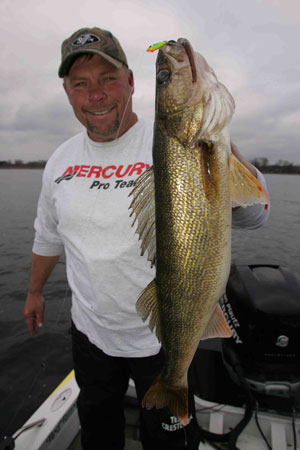|
Walleyes Under the Radar
by Ron Anlauf
There are a lot of unanswered questions surrounding the early walleye season like; What kind of lake would be best? How deep will they
be? Will they be holding on rocks or gravel, sand or weeds? The answers
to these questions can be summed up in one simple term; it all depends.
walleye season like; What kind of lake would be best? How deep will they
be? Will they be holding on rocks or gravel, sand or weeds? The answers
to these questions can be summed up in one simple term; it all depends.
Picking a lake to get the season started can be as simple as going
with a big name like Mille Lacs, Leech, or Winnebago, etc. They’ve got
what it takes, namely thousands and thousands of walleyes. But along
with all of
those fish comes pressure, and lots of it. A better choice might be a
sleeper lake, one that has a decent number of fish but really isn’t
getting the recognition. Sleeper lakes can be natural producers, or rely
on heavy stocking efforts to support fishable number of walleyes, or
could be a combination of both. It’s the stocked lakes (natural
producing or not) that
have the best chance of falling beneath the radar. Stocking is the
wild card as you never know when a particular class of stocked walleyes
is going to take hold and show up in decent numbers. When it does the
action can be phenomenal, but only if you know the opportunity is there.
DNR websites and stocking information can help, especially the lake
surveys that include test netting results. Big year classes of fish that
stack up back to back can make for an ideal situation and deserves some
opening day investigation. Professional guide and PWT competitor
Richie Boggs of Nisswa, Minnesota spends countless hours plying the
waters of stocked lakes and offers some early season advice: “There’s a
bunch of lakes in the Brainerd area that don’t get all that much
pressure and are really good early in the season. What I usually look
for are areas close to any incoming tributaries on the north end of the
lake. Creeks or streams coming in could have attracted spawning walleyes
and the north end of the lake is where the warmer water usually ends up.
It’s also where you can find weed growth that is more developed and
weeds can be a real key to finding good numbers of early season
walleyes.”
To put a few of them in the boat Richie will often employ the use of
a live bait rig like many other anglers, but he does it with a twist;
“Instead of the usual rig I’ll crimp on a split shot a few feet ahead of
a red hook and let out about a hundred feet of line. All that line gets
the bait away from the boat which can make a big difference especially
when its calm and I’m dealing with spooky fish. I also like to use
leeches or minnows early in the season as it’s usually a little to cold
for crawlers.”
Another technique he uses when working shallow water (maybe two to
three feet deep), is to troll with the smallest Husky Jerks and let out
about a hundred feet of Fireline. “I’ll use the tiny cranks when the
wind is blowing and the waves are pounding into a good area. Wind and
waves can turn fish on and bring them up into really shallow water where
they’re often aggressive enough to chase down a crank bait. It
also allows me to cover some water and up my odds for finding the
biters” Richie will switch up tactics when he finds fish holed up in
smaller areas like on a rocky bar or reef, or an isolated patch of
weeds. “In that case I’ll drop the anchor and throw out slip bobbers and
leeches and really work the area over. A good spot can produce a lot of
fish if you give it enough time, and by using a slip bobber you can keep
your bait exactly where you want it.”
Professional fisherman and Team Crestliner member Dan Plautz of
Muskego, Wisconsin uses another approach for finding overlooked walleyes
and includes the use of a fourteen foot jon boat; “In my neck of the
woods there’s a few small lakes in the two to six hundred acre range
that have decent populations of walleyes but have poor ramps and are
tough to get in to. We can still get in there with a jon though, and
pretty much have it to ourselves.”
Dan’s top techniques includes getting on the water early and casting
floating cranks and working the tops of rock humps and weed beds; “We’ve
done really well casting cranks early in the morning and again just
before dark. During the day I’ll slowly move the boat along with a Minn
Kota and pitch 1/16oz jigs tipped with redtail chubs and work the weed
edges. If there’s enough wind I’ll drift with a Northland Tackle Roach
Rig combined with a Gum-Drop Floater tipped with a minnow or a big leech
and keep pitching the jig and minnow at the same time. The little
floater will help keep the bait riding just over the tops of newly
emerging weeds where walleyes can get a good look at it.”
Avoiding the crowds is the big draw to “under the radar walleyes” and
in my mind the key to a quality experience. The extra homework and a
little investigative angling could be well worth effort, especially when
you’ve put it all together and are able to slip the net under that first
fish. There are no guarantees but that’s part of the challenge, and the
fun. See you on the water. |





 walleye season like; What kind of lake would be best? How deep will they
be? Will they be holding on rocks or gravel, sand or weeds? The answers
to these questions can be summed up in one simple term; it all depends.
walleye season like; What kind of lake would be best? How deep will they
be? Will they be holding on rocks or gravel, sand or weeds? The answers
to these questions can be summed up in one simple term; it all depends.